Overview
For the final project, I was excited to expand upon my systems game Enshittification, which sought to model the evolution of a social media app from initial growth as an ad-free, community-centered personal passion project into a privacy-invading, enormously profitable ad-center. It’s a trend we’ve seen with Facebook, Snapchat, and most recently TikTok–what starts as something that seems too good to be true, well, is.
My primary focus when refining the game was to introduce a live social feed of the social media you’ve created and are now destroying. Or making profitable–whatever description you think fits better. While the simplicity of the initial version, relying on the bizarrely intoxicating joy of seeing numbers go up, was successful at being an engaging game (at least to a healthy portion of playtesters), it failed to demonstrate any of the consequences of your singularly profit-minded choices. I was reminded of feedback I got for my first game, Sunnyvale CA, where a playtester suggested that he found himself sympathizing with NIMBYs and agreeing with them while the intention of the game was to demonstrate the harms of NIMBY behavior. The problem was that nothing in that system actually demonstrated or reflected those consequences. In the initial version of the game, you don’t see any of the human consequences of your behavior. There are financial consequences that are modeled, such as user backlash to privacy invasion or user loss due to too many ads, are still complete abstractions from the human effects that this decision-making has.
By introducing a parallel feed, where you could see how people were actually (theoretically) being affected by your decisions, the game becomes deeper by offering a new perspective and motivation to the player. But the fact that the feed never had an effect on the game was entirely intentional–profits don’t care about how happy an online community is, they care about how many ads they see. It’s up to the player to decide what they care about. Will they focus on the feed, making sure that users are still having positive experiences? Or will they ignore the feed in favor of watching those juicy numbers climb and climb? We know what happens when the big guys are in charge–are you any different?
Playtests

The first iteration of Enshittifcation beyond P3 that I playtested introduced a very rudimentary version of my vision. There was a phone-like container with a constant feed that was loosely connected to the rest of the game. The two playtests I conducted with this version of the game went very differently. In the first (left), the playtester seemed engrossed in the game. She was delighted that the feed was filled with positive messages, calling out “they’re so happy!!”. At another point she said “It’s coming the the point where I have to make a tradeoff but I don’t want too!!” It was rewarding to see how bought in she was to the game, and a lot of this investment, she reported, was specifically directed towards the comments. She looked to them to make decisions, although after I let her know they were only an early prototype and not closely aligned with the rest of the game, she paid less attention to them and more to the dashboard.

The other playtest I ran with this exact same version was not as positive for me. Instead of engaging with the comments, the playtester seemed to only focus on the dashboard. It was clear when watching them, and was confirmed afterwards, that they had the goal of getting money to advance to the next algorithm level. The way that they approached this was by slowly increasing the ads. However, this lead to a loss of users which meant that they were earning less and less money, until they had so few users that they were hardly earning anything at all. It seemed like the playtester was not aware that this is what was happening, and instead of taking action to change course, they patiently waited for the money to increase. Afterwards, they reported feeling like there was one strategy, and they were sticking to it even if it would take a while to wait. Notably, they skipped the tutorial that was in place, which may have helped them understand the interactions between the users and money better, but the fact that it’s easy to skip without knowing that you’re skipping it is another fault of the design. They also said that the comments were easy to ignore, which isn’t necessarily bad, since it’s part of the commentary I’m trying to make, but it was fascinating to see that difference of opinion.
Based off of these playtests, it was clear to me that I had to improve the tutorial system so that players could have an easier time understanding what is going on in the system. The tutorial that was in place was still a fairly steep learning curve, and I had to find a solution to that. However, I was eager to get the feed aligned with the choices that the player was making, so, against my better judgement, that is where I directed my effort. In fairness, that is the part of the game that I said I would focus on when making my project plan, and it was the aspect that the first playtester was most excited about too, but subsequent playtests would confirm that it was not the right way to go. A number of other small changes were

 The third and fourth playtests, proceeded closer to the second playtest than the first. While the content ofthe messages was better aligned with the choices they were making, it still had some ways to go. The first player especially enjoyed messing with the ad percentages to see how the comments would respond. At first they were excited that it seemed to respond to what he was doing, but at some point when he had the ad percentage high, there were a couple of comments commending the app for being ad free, and he was audibly disappointed at the confusion. This was the result of a bug in my code, but the visceral reaction confirmed to me that it was important for the content of the feed to be aligned with the player’s actions.
The third and fourth playtests, proceeded closer to the second playtest than the first. While the content ofthe messages was better aligned with the choices they were making, it still had some ways to go. The first player especially enjoyed messing with the ad percentages to see how the comments would respond. At first they were excited that it seemed to respond to what he was doing, but at some point when he had the ad percentage high, there were a couple of comments commending the app for being ad free, and he was audibly disappointed at the confusion. This was the result of a bug in my code, but the visceral reaction confirmed to me that it was important for the content of the feed to be aligned with the player’s actions.
The bigger takeaway, however, from these two playtests is that it was still very easy to be confused about what you were supposed to do. Players didn’t really seem to get what the sliders meant and they didn’t understand why they were there. Eventually through enough playing around and some hinting on my behalf, they figured it out and started having more fun. But this process was not a fun and exciting type of exploration, but rather a confusing frustrating process during which I’m guessing many non-playtesters would have given up and stopped playing.
I finally accepted that I had to make a better tutorial. I had also been feeling like it would benefit the game to include an “angel investor” character, an important figure in the system I was modeling that often puts plenty of pressure on people to grow their users to ultimately maximize profits. I saw these as the perfect fit for each other. Instead of the tutorial being a bunch of boring words from a modal, I would have the investor teach it to them. The bigger change, however, is that every element would be introduced one at a time, so the player wouldn’t be overwhelmed by the complexity of everything all at once. Following in the footsteps of Plants v. Zombies, I only introduced each element when it was relevant to the player.
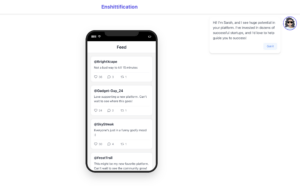
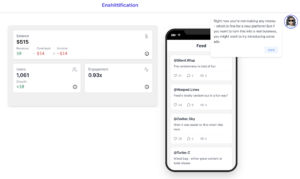


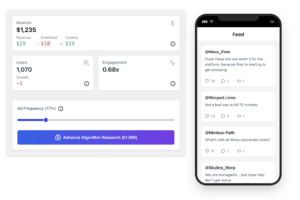
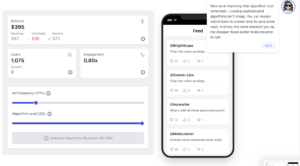
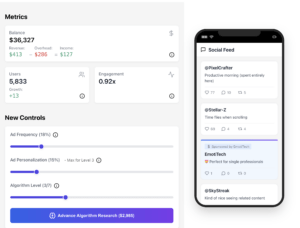

The first person to playtest this new tutorial was new to the game and I hadn’t told them anything about it, but the tutorial really seemed to do the trick. They weren’t especially confused by any of the controls as they popped up. They took their time reading through the messages on the phone before talking to the investor, so they had almost formed a connection with their app. When the investor first mentioned ads, the playtester said “Oh you’re gonna make me ruin it!” a delightful emotional response that wouldn’t be possible with the previous version.
However, after she made it through most of the tutorial, she said “Okay now what.” I didn’t respond and later she said “What’s the point” and asked if she could buy stuff with the money she was accumulating. I had assumed that the allure of numbers going up would be enough to entrance any playtester into attempting the goal of just getting more money, but, especially after the more well-structured tutorial, there was a weird gap. So for the next iteration, I implemented a final key changes: a win and loss condition.

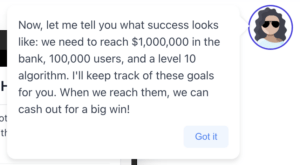

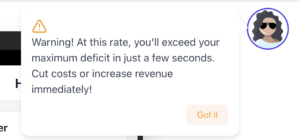
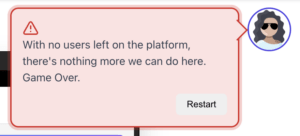
With these win and loss conditions in place, the players should have a clear goal, direction, and hopefully sense of progress as they get more money and evolve their platform.
 I conducted one final playtests with these goals. This playtester had already played the P3 version of the game and was delighted with the changes. They said that the slow introduction of the different tools was a lot less confusing and seemed to really enjoy reading the feed–at least at first. It seemed that they settled into a rhythm where they were moving the ads up and steadily increasing their algorithm. They were focused on the goals and filling up those bars. But then they let out a “Woah” when they read the feed for what seemed like the first time in a while. They were shocked that it had devolved into all-caps anger and cursing towards the ads and people lamenting that they had been on the app all night even though they didn’t want to. When I asked them about it, they said they were focused on the numbers and there was so much movement in the phone that they started to ignore it, but when they looked back at it for the first time in a while, they realized the decisions, driven by those completion bars at the top, were affecting the app’s users more than they had thought.
I conducted one final playtests with these goals. This playtester had already played the P3 version of the game and was delighted with the changes. They said that the slow introduction of the different tools was a lot less confusing and seemed to really enjoy reading the feed–at least at first. It seemed that they settled into a rhythm where they were moving the ads up and steadily increasing their algorithm. They were focused on the goals and filling up those bars. But then they let out a “Woah” when they read the feed for what seemed like the first time in a while. They were shocked that it had devolved into all-caps anger and cursing towards the ads and people lamenting that they had been on the app all night even though they didn’t want to. When I asked them about it, they said they were focused on the numbers and there was so much movement in the phone that they started to ignore it, but when they looked back at it for the first time in a while, they realized the decisions, driven by those completion bars at the top, were affecting the app’s users more than they had thought.

